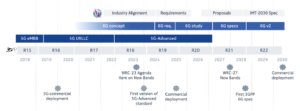Interview with Peter Merz from Nokia

Peter Merz
While 5G is still being rolled out, preparations for 6G are gaining speed. That raises questions about the path towards 6G, and why we need 6G in the first place. Eurescom message editor-in-chief Milon Gupta asked Peter Merz, Head of Nokia Standards, about it. Mr. Merz is responsible for Nokia Standards including related standards research activities in areas like radio/RAN, core, network management and automation as well as network security.
Why do we need 6G?
Peter Merz: Wireless technologies are of critical relevance for our society and economy today; their importance for economic growth, wealth and sustainability will continue to steadily increase with 5G and its evolution, enabling new ecosystems and services motivated by growing traffic and trillions of devices.
Human intelligence will be augmented in the world of 2030 by being tightly coupled and seamlessly intertwined with the network and digital technologies. This will call for a shift in the way communication networks are designed. While 5G enables us to consume digital media anywhere, anytime, future technology should enable us to embed ourselves in entire virtual or digital worlds.

3GPP timeline of 5G to 6G releases
What are the benefits of 6G compared
to 5G-Advanced?
Peter Merz: 5G-Advanced will further develop 5G to its fullest capabilities over the coming decade. Improvements in uplink capacity and handling of mobility will be combined with the inherent high data rate and low latency capabilities of 5G to create a fully immersive user experience while on the move. It will also bring innovations for improved coverage, resilient timing services that will facilitate diverse new services, enhanced low-cost massive IoT, and further support for non-terrestrial networks (NTN) and drones.
6G will go even further, calling for a change in the way communication networks are designed. Multiple key requirements must be reconciled: serve the massively growing traffic and the exploding numbers of devices and markets, while also accomplishing the highest possible standards regarding energy efficiency, strong security, and efficiency in coverage and operation, for enabling sustainable growth in a trustworthy way.
European R&D on 6G started in 2020. Where do we stand now?
Peter Merz: In general, countries and regions around the world make investments in all areas of technology and innovation. In January 2021, the European Commission 6G flagship research project Hexa-X, which is being led by Nokia, was officially kicked off. Being a 2.5-year project within the EU’s Horizon 2020 ICT-52 program, Hexa-X displays European leadership in 6G, and European research projects have been at the forefront of research for many generations of mobile networks. This strong experience and track record in collaborative research will be an advantage in achieving European 6G leadership.
Horizon Europe will make 900 million euro in funding available for 6G by the end of the year. This is complemented by dedicated substantial 6G funding programs in Germany, France and Finland.
How will 6G change the ICT landscape and vertical industry sectors?
Peter Merz: 5G is the first system designed to make inroads into the industrial environment, and the transformation to Industry 4.0 featuring the first wave of wireless-enabled automation will already have happened well before 2030. 5G networks providing ultra-reliable low-latency communications (URLLC) will have facilitated real-time processing in the cloud. However, special industrial use cases relying on much more extreme requirements for wireless communication will require 6G to augment 5G.
Take, for example, holographic telepresence, which will become the norm for both work and social interaction. Another example is the massive future use of mobile robot swarms and drones in various verticals such as hospitality, hospitals, warehouses and package delivery. Think also of dynamic digital twins in the digital world with increasingly accurate, synchronous updates of the physical world.
Which are the next steps on the path towards 6G?
Peter Merz: We expect 6G systems to launch commercially by 2030, following the typical 10-year cycle between generations. Standardization phase 1 will likely start from 2025 as part of 3GPP Release 20.
Meanwhile 5G will be enhanced by 5G-Advanced, which will be a key focus for 3GPP in Release 18 onwards and will power commercial networks starting 2025 onwards well before 6G arrives at the end of the decade.